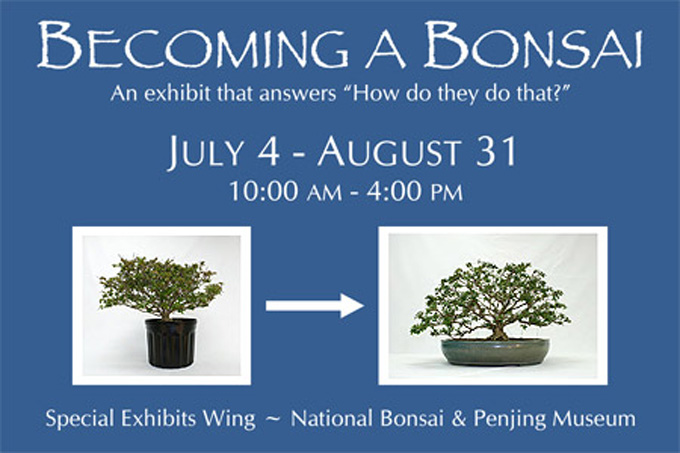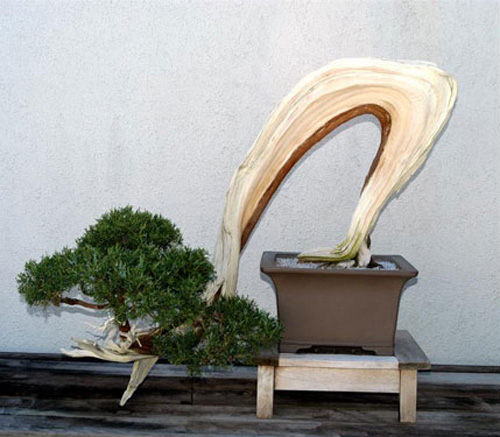 A good reason to visit the National Bonsai and Penjing Musem? Maybe. But whatever your reason, it’s always a trip worth making.
A good reason to visit the National Bonsai and Penjing Musem? Maybe. But whatever your reason, it’s always a trip worth making.Don’t read this post
What follows is way more polemic (and wordy) than any of my hundreds of previous posts (a rough night’s sleep is my excuse) and besides, I love the people at the National Bonsai and Penjing Museum and am loath to offend them. Still, the anti-diplomat in my nature insists on speaking his mind (always a dangerous thing).
An American tradition: bonsai from ordinary nursery stock
Mr. Aarin Packard, Assistant Curator of Collections at The National Bonsai & Penjing Museum, has created an interesting display titled ‘Becoming a Bonsai.’ Though I am big fan of the Museum and the folks at the National Bonsai Foundation who work with love and devotion to create and preserve a world class museum, and the display is professional, attractive, well laid out, easy to follow and altogether well done, still there are issues that a display of this type brings up.
Is it really how they do that?
I don’t think this is intentional, but even though the poster above purports to answer the question ‘How do they do that?’ the bonsai-from-nursery-stock approach has very little to do with how the bonsai at the museum (or pretty much any quality bonsai) comes into being (this may be an overstatement, as some of the techniques mentioned do apply to most bonsai, but I’ll stick to my guns).
This is not to say that there is anything wrong with trimming and wiring a well-chosen plant from a nursery and putting it in a bonsai pot (check out our $1,000 Bonsai from Scratch Contest – BTW: it’s not too late to enter). People do it all the time and many derive great satisfaction in the doing and the results. In fact, I would venture a guess that some contemporary bonsai artists got their start that way.
Beginning, middle and end
What’s so different about bonsai from nursery stock and quality bonsai? One way to approach this issue is to look at the beginning, middle and end (except for death, there really isn’t an end with bonsai) of the process we call bonsai.
The beginning: Quality bonsai starts with quality stock; almost all world class bonsai come from well-chosen collected stock or with material grown specifically for bonsai (usually field grown). The vast majority of bonsai from nursery stock will never rise above a somewhat charming little plant in a bonsai pot (the real truth is that the majority of bonsai from nursery stock will be dead within a year).
The middle: So much more than meets the eye has gone into a quality bonsai. Most of this is about time and skill. The time spent developing quality bonsai almost always amounts to years or even decades. Quality bonsai (bonsai art) just doesn’t happen overnight. This also applies to acquiring the skills necessary for styling and maintaining quality bonsai; again it’s about years, decades, or even lifetimes.
The end: The little nursery plants in bonsai pots don’t look like the quality bonsai you see in the Museum and elsewhere and the almost none ever will. This is not necessarily a problem, but is a distinction worth noting.
The real culprit: oversimplification
Perhaps oversimplification is the real culprit here (could this be a double edged sword?). Below are three examples from the Museum’s Becoming a Bonsai’s Key Concepts:
• The goal of every bonsai is to resemble a tree in nature.
• A bonsai should have the impression of great age.
• The shape of a bonsai should have a pleasingly balanced form.
• The goal of every bonsai is to resemble a tree in nature: Bonsai don’t have goals, people do. But that’s just a little grammatical thing. Though I know John Naka promoted the ‘tree in nature’ approach, and it’s an excellent approach, still not all bonsai look like trees in nature. Some bonsai are so abstract and sculptural that you would be very hard pressed to ever find a tree in nature that they resemble. True, some people don’t appreciate this highly stylized look, but few would argue that it isn’t bonsai (if you did, you’d be arguing with Masahiko Kimura, among others).
• A bonsai should have the impression of great age: Many quality bonsai do give the impression of great age, but not all do. But perhaps the most questionable part of this statement is the use of the word ‘should.’ Most people deeply involved with bonsai, view it as an art; and ‘art’ and ‘should’ are always destined to part ways.
• The shape of a bonsai should have a pleasingly balanced form: I wonder what the distance between pleasingly balanced and boringly balanced is? Perhaps dynamic (existing in the gap between balanced and unbalanced?) is more interesting. And there’s that word ‘should’ again.
Nuff said. Now for the slings and arrows.
 An excellent reason to visit the National Bonsai and Penjing Museum. A photo will never do the stunning power of this ancient tree any justice. Until you see the real thing, you’ll never quite understand.
An excellent reason to visit the National Bonsai and Penjing Museum. A photo will never do the stunning power of this ancient tree any justice. Until you see the real thing, you’ll never quite understand.  California juniper, from nursery stock (just kidding). A striking example of a bonsai that doesn’t exactly resemble a tree in nature (even though it was collected in nature, but much has happened since then). You can view this impressive bonsai by Harry Hirao (Mr. California juniper) at the National Bonsai and Penjing Museum.
California juniper, from nursery stock (just kidding). A striking example of a bonsai that doesn’t exactly resemble a tree in nature (even though it was collected in nature, but much has happened since then). You can view this impressive bonsai by Harry Hirao (Mr. California juniper) at the National Bonsai and Penjing Museum.Source: Bonsai Bark
0 comments:
Post a Comment